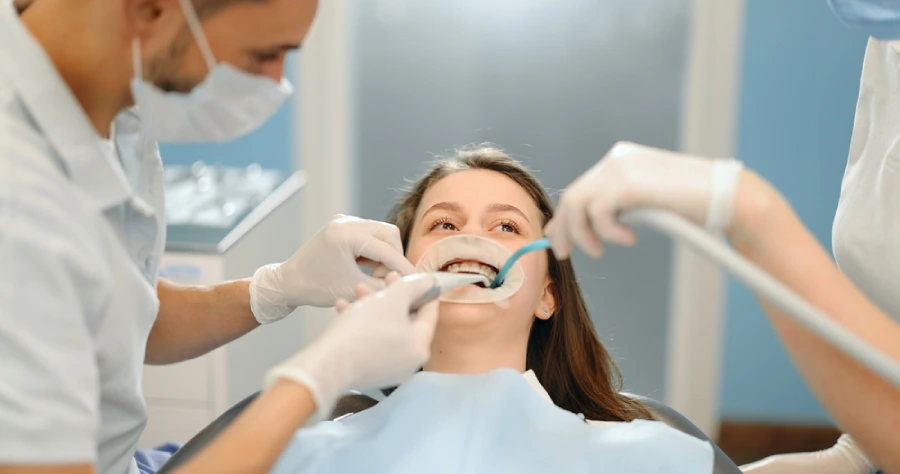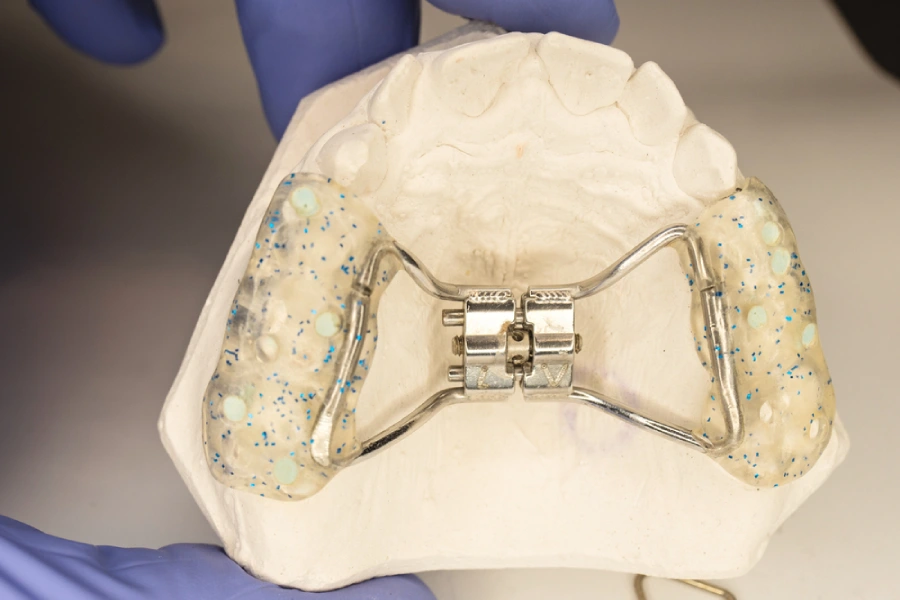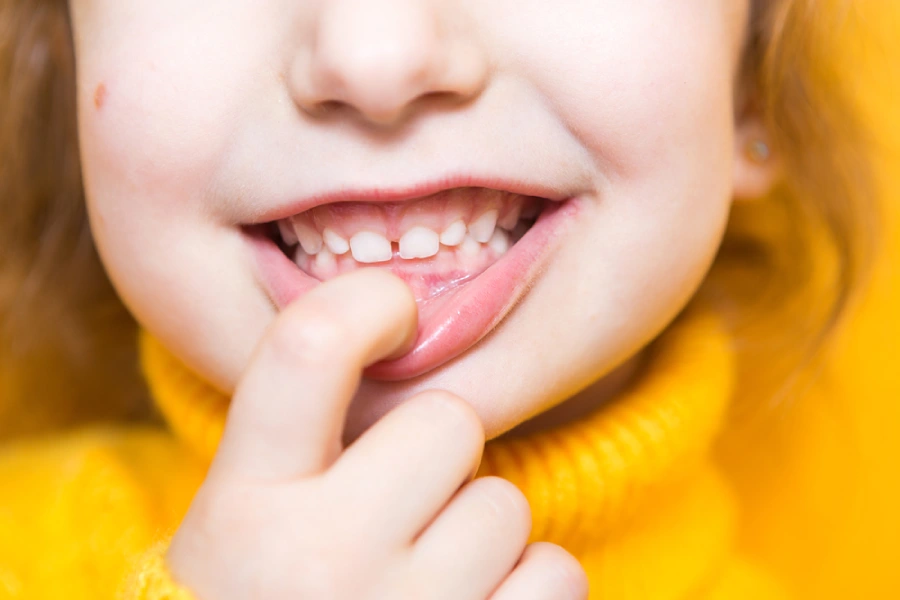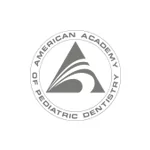
For parents, oral hygiene for kids is paramount. However, helping your child brush, floss and develop a clean, healthy smile can be difficult, particularly for parents who lack insights into their children’s oral health.
Perhaps this is why the number one chronic disease among preschoolers is tooth decay. One out of 10 two-year-olds have one or more cavities. By age three, 28% of children have one or more cavities and by age five nearly 50% of children have one or more cavities.
The Super Dentists is committed to educating parents and children alike, and as such, we’re here to teach you about the ins and outs of oral health for kids. In this children’s teeth parents guide, we will go over some of the key questions to consider about your child’s oral health, and how you can help your son or daughter maintain beautiful teeth.
Start with a Daily Oral Health Routine
While brushing teeth is probably not at the top of the “fun things to do” list for a child, instilling good dental hygiene for kids from an early age is essential for a lifetime of healthy teeth.
One of the best things a parent can do to help promote good oral hygiene for kids is model tooth brushing habits in front of your children. Parents modeling their dental care helps normalize it for kiddos. We all know that children model their behavior from parents, so showing rather than only telling about healthy tooth brushing routines will help them learn quickly!
A consistent daily routine of brushing and flossing is as essential as visiting the dentist’s office for checkups and cleanings. Children should brush their teeth twice each day with a fluoride and/or hydroxyapatite toothpaste, as either ingredient helps prevent tooth decay and fluoride makes your child’s teeth stronger.
The Super Dentists recommend brushing before breakfast and before bedtime at night. The mouth becomes acidic for about 30-60 minutes after eating or drinking so it’s important that you never brush your teeth immediately after eating or drinking food or drinks.
Here is a daily routine to promote healthy teeth for kids and set them off on the right path:
- Set time each morning and night for teeth cleaning, and try to make it fun instead of a dreaded task.
- Listen to your kids’ favorite music or sing songs as a brushing timer. Kids brush 73% longer listening to music.
- Add a silly brushing dance to your routine.
- Play a funny video on your smartphone to pass the time.
- Use one of these fun toothbrushing apps.
- SuperMouth app will bring all of your favorite Super Dentists characters to life using augmented reality.
- The Toothsavers Brushing Game helps kids track their own brushing in a fairy tale land.
- Disney Magic Timer by Oral B allows kids to navigate tooth brushing time with Disney, Marvel and Star Wars characters.
Why It Is Important to Help Prevent Cavities in Children
Maintaining your children’s oral health routine is a huge part of helping to prevent cavities in children. If we do not teach the importance of a good oral health routine, your child might have to face an uncomfortable dental procedure. Cavities (tooth decay) are permanently damaged areas on the hard surface of the teeth, which turn into small holes or openings.
While cavities are some of the most common pediatric oral health problems, there are many things that both parents and children can do to help prevent them from forming. While cavities are very common in children, teenagers, and adults, you might be surprised to know that even infants can get cavities.
Dental Health for Babies
Tooth decay in babies is often called early childhood caries or baby bottle tooth decay. Babies can develop tooth decay because of the bacteria in their mouths. The bacteria then forms plaque, which eats away at tooth enamel.
Healthy dental health for kids should begin early because tooth decay can develop as soon as the first tooth comes in causing problems with speech, eating and adult teeth that will eventually come in.
To set your baby’s teeth up for success, here are some simple procedures to follow for infant oral care.
Children three years old and under:
- Wipe your child’s gums twice a day with a soft, clean cloth or silicone finger sleeve in the morning after the first feeding and before bed.
- When teeth come in, start brushing twice a day with a soft, small‑bristled toothbrush and water.
- Visit the dentist by your baby’s first birthday to spot signs of problems.
- Become familiar with the appearance of healthy gums, so you can identify any problems with your child’s gums or teeth.
- Talk to your pediatric dentist or doctor about putting fluoride varnish on your child’s teeth when the first tooth appears.
- Regular dentist visits.
Dental Health for Toddlers
Outside of a good oral care routine, there are a few important things parents can teach their children to aid in good oral health. For one, a child’s diet is paramount in keeping caries from developing. Sticky sugars can stick to the baby teeth and create plaque, so it’s important to limit the amount of juice, candy and dried fruit a child habitually indulges in as it can lead to bad dental hygiene for kids.
Secondly, making sure your child is getting fluoride varnish at dental appointments can prevent around 33% of cavities in baby teeth. Another great option for supporting great kids dental health is having The Super Dentists apply dental sealants to the chewing surfaces of the back teeth, said to prevent 80% of cavities.
Below is a longer list of things you as caretakers can be doing to help promote healthy teeth for kids (children six years and older).
- Avoid sticky sugar foods.
- Ask your child’s pediatric dentist to apply dental sealants when appropriate.
- Choose an appropriately sized toothbrush.
- Don’t let your child go to bed with a bottle.
- Only allow water to drink after brushing before bed.
- Floss at least once a day using a safe and effective floss.
- Help brush your child’s teeth twice a day with hydroxyapatite and/or fluoride toothpaste.
- Regular dentist visits.
When teaching your children to brush, parents only need to use a pea-sized amount of toothpaste and encourage your child to spit out the toothpaste rather than swallowing it.
Children should start flossing once a day when teeth begin to grow next to each other. The tongue should also be brushed to remove bacterial plaque. If your child doesn’t like brushing their tongue, use a tooth scraper.
Dental Health for Children
Cavities in children is a problem that can be prevented. About 20% of children ages 5-11 years old have at least one untreated decayed tooth. This is why it is important to teach dental health for kids when they are young.
When your child reaches 8-9 years old, it’s time for them to take over control of their teeth brushing duties. By this age, most children have developed the dexterity to effectively reach all the teeth in the front and back of their mouths. However, don’t get too excited handing over the reins of oral hygiene because adult supervision is still recommended.
Teach these easy steps for outstanding dental hygiene for kids.
- Apply a pea-sized amount of toothpaste.
- Angle the toothbrush at 45 degrees towards the gums of the upper or lower teeth.
- Move the brush gently back and forth with short strokes.
- Hold the toothbrush in a vertical position to brush the front teeth.
- Brush the tongue to remove bacteria.
- Brush teeth and tongue twice a day, for two minutes each time.
Effects of Poor Dental Hygiene in Kids
It is extremely beneficial and important to teach good dental hygiene for kids. Without proper brushing and flossing techniques, as well as guidance from parents, children are at risk to develop tooth decay.
Cavities are uncomfortable enough for adults, and can feel even more uncomfortable for children to experience. Untreated cavities can cause pain, infections, and can even lead to problems with speaking, eating, learning, and playing.
To ensure that your child does not have an untreated cavity, bring your child to their dental check ups within six months of the first tooth coming in, or at the latest, 12 months old.
Attending regular dental visits every six months not only helps prevent cavities, but helps children understand the importance of good kid’s oral health.
How Can Parents Help Prevent Children’s Cavities?
Keeping the gums and teeth clean will enable your child to minimize the risk of cavities. Also, if you teach your child about proper brushing and flossing techniques, he or she may be better equipped to avoid cavities both now and in the future. In addition to proper brushing and flossing techniques, there are other things parents can do to help prevent cavities, including:
- Start good habits early
- Supervise children under age 8 when brushing and flossing
- Ensure that your child gets enough fluoride
- Limit or avoid sugary foods and drinks
- Take your child to regular dental check ups
While you can help prevent a child from developing cavities, they can still develop anyway. Many factors may impact the development of cavities, including:
- Lifestyle
- Diet
- How an individual takes care of his or her teeth
- The presence of fluoride in the water that an individual uses day after day
- The use of toothpaste
- Genetics & family history
If cavities go untreated, they can destroy teeth. Or, cavities could cause nerve damage to a tooth, leading to an infection at the root tip that may require surgery or tooth extraction.
Ultimately, there are many ways to ensure your child can avoid cavities, such as:
- Brush the teeth at least twice a day with a fluoride toothpaste.
- Floss daily to eliminate plaque from between the teeth and under the gums.
- Limit the intake of starchy and sugary foods, i.e. foods that may cause plaque acids that can lead to tooth decay.
Teach your child about the importance of oral health at a young age – you’ll be glad you did. By doing so, your son or daughter will be able to learn about proper brushing and flossing techniques and minimize the risk of cavities.
Are There Specific Brushing Techniques That Your Child Should Use?
For children, getting the hang of brushing the teeth may seem impossible at times. Fortunately, there are several steps that you can use to help your child become accustomed to brushing his or her teeth:
- Place a pea-sized dab of hydroxyapatite and/or fluoride toothpaste on a soft-bristled toothbrush.
- Brush the inside and outside of the child’s teeth, and move the toothbrush gently back and forth across the teeth.
- Place the toothbrush at an angle and move it back and forth along the child’s outer gum line.
- Brush back and forth along the tooth’s chewing surface.
- Using the tip of the toothbrush, clean behind each tooth and on the top and bottom of the tooth.
- Brush the tongue softly.
Spend some time teaching your child about proper brushing techniques. You also can use this opportunity to educate your child about the importance of oral health practices and bond with your child simultaneously.
When Should Your Child Begin to Floss?
Flossing the teeth will help your child protect the gums. The American Dental Association recommends flossing the teeth daily, and doing so helps reduce the risk of gum disease, cavities and other oral health issues. Also, new studies are linking flossing to an increase in life-expectancy, with some showing a six-year increase for people who floss regularly.
Many parents begin flossing their children’s teeth at the age of 2 , or as soon as your child’s teeth begin to fit closely together.. You might notice this happening as early as 18 months, but it can also happen as late as 6. If you are unsure your child is ready for flossing, the best thing you can do is talk to your child’s pediatric dentist.
Flossing will allow you to eliminate food particles and plaque between your child’s teeth that brushing misses, ensuring you can keep his or her teeth looking great.
Furthermore, many children are able to floss on their own by the age of 8. And if you teach your child about flossing now, he or she should have no trouble transitioning to flossing on their own.
When teaching your child to floss, there are some things that you can do to help make the process a little bit more enjoyable:
- Floss together
- Make silly faces in the mirror
- Let your child choose their floss
- Use a reward system
- Create a flossing chart to encourage your child to floss every day
What Type of Floss Is Best For Kids?
There are two types of floss that kids can use, and both work equally as well to remove food particles from their teeth.
Traditional Floss
When using traditional floss, teach your child to wrap the floss around their index fingers. The amount of floss you break off is up to you, but your child can use as much as 18 inches of floss at a time. Show your child how to slowly glide the floss between the teeth, getting along their gum lines of the top and bottom teeth.
Avoid any floss with PTFE (Teflon), petroleum-based wax (microcrystalline) or any other potentially toxic and dangerous ingredients or waxes. Instead, shop for safe flosses with expanded technology that have been shown to remove 40% more plaque.
Floss Picks
Most kids prefer to use floss picks because they are easier to handle. This might be the best option for teaching children to floss because it is a good option for younger children who have not yet developed the dexterity that many adults have when flossing. Floss picks are simple to stick between each tooth, and they are easier for small children to grasp.
How Can Diet Impact Your Child’s Oral Health?
A balanced diet is essential for a child to maintain strong, healthy teeth. In fact, a diet that features foods rich in vitamins and minerals will support your child’s growth and development and oral health.
A balanced children’s diet consists of all three food groups, which are fruit and vegetables, protein, and whole grain products. Children need three meals a day, and can have up to three snacks too.
Snacks are typically in the morning, afternoon, and before bedtime. It is important that children’s snacks are just as healthy as their meals throughout the day. Good oral health for kids is often impacted by their nutrition, which affects their oral and overall health.
It also is important to note that frequent snacking can affect your child’s oral health. Cookies, dried fruits, potato chips and other sugary and starchy foods can combine with plaque to create acids that attack tooth enamel. As a result, frequent snacking may lead to cavities and other oral health problems.
In addition, a diet should feature the proper amount of fluoride, a naturally occurring mineral that is found in many foods and beverages. Fluoride makes the outer surface of the teeth (enamel) more resistant to acid attacks and has been shown to help individuals combat cavities. Your pediatric dentist can provide you with full details about fluoride and how much fluoride your child should have in his or her diet.
Lastly, if you ever have oral health concerns or questions, feel free to contact The Super Dentists – we’re pediatric dentistry and oral health experts and are happy to assist you in any way we can.









